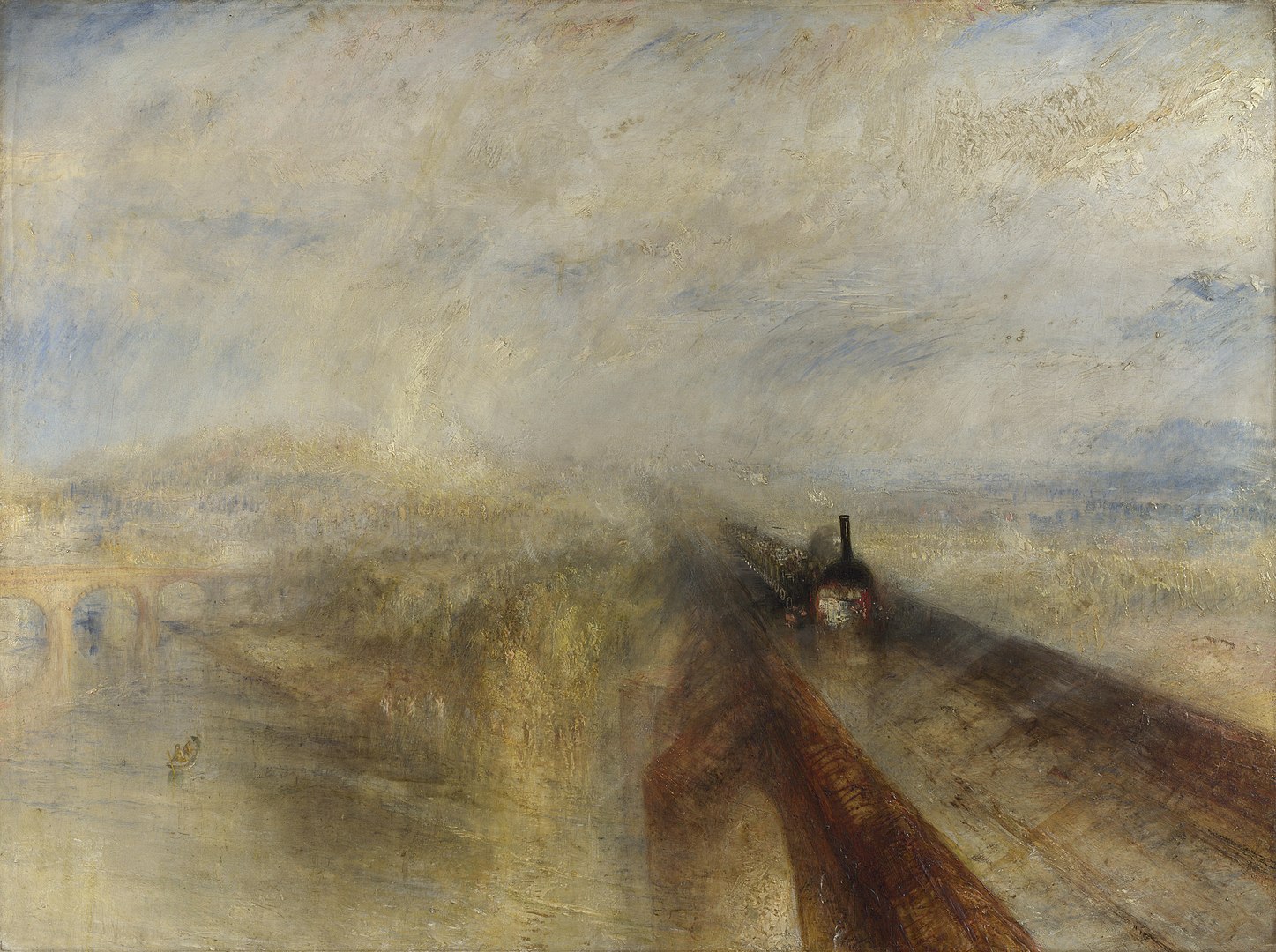
Rain, Steam, and Speed – The Great Western Railway: A Journey Through Turner’s Vision of Modernity, Nature, and Time
Joseph Mallord William Turner’s Rain, Steam, and Speed – The Great Western Railway is widely recognized as one of the most enigmatic and emotionally stirring masterpieces of 19th-century British art. Painted in 1844 and currently housed in the National Gallery, London, this work represents a transitional moment in both the career of Turner and in the history of Western art. Through masterful brushwork and luminous color, Turner conjures a powerful scene of a locomotive hurtling through mist and storm across a bridge. However, far beyond being a mere depiction of a train, the painting is a profound meditation on progress, nature, and the fleeting nature of time. This story delves into the rich symbolism, interpretive layers, artistic style, and cultural context of Rain, Steam, and Speed – The Great Western Railway.
What Is Rain, Steam, and Speed – The Great Western Railway About?
At first glance, Rain, Steam, and Speed appears to be a dramatic landscape painting capturing a modern locomotive racing across a viaduct through inclement weather. But to dismiss it as simply a romanticized view of the industrial age is to miss its deeper meanings. Created during a time when Britain was undergoing rapid industrial transformation, the painting embodies the collision between the natural world and human innovation.
Turner’s train, dark, fierce, and resolute, emerges almost ghost-like from the fog. It is bound by no pastoral tranquility; instead, it challenges the traditional view of nature as calm and eternal. With its vivid brushstrokes and abstraction of form, Turner uses this seemingly straightforward scene as a canvas upon which to explore broader existential questions. What is the cost of progress? Is humanity mastering nature or merely hurtling toward an uncertain destiny? Turner paints not only a machine but a metaphor.
Visual Analysis: What’s Happening in the Painting?
The setting of the painting is the Maidenhead Railway Bridge, an architectural marvel designed by Isambard Kingdom Brunel, and an iconic symbol of engineering prowess of the era. The bridge spans the River Thames near Maidenhead, and in Turner’s rendering, it appears as a sweeping, almost ghostly form beneath the train. The year is 1844, and Turner captures a train of the Great Western Railway, one of the first railroads connecting London to the West of England.
The locomotive dominates the right half of the canvas, plunging toward the viewer. It’s a striking visual device, creating a sense of immediacy and even danger, as if the train is about to burst forth from the canvas. Yet the machine is shrouded in steam and rain, barely distinguishable from the swirling elements around it. The left side of the painting features a golden light breaking through clouds, a glowing contrast to the murky scene ahead. On the bridge in front of the train, a small hare is barely visible, sprinting in a desperate attempt to outrun the unstoppable iron beast.
This seemingly minor detail, the hare, serves as a vital clue to the meaning of the painting.
Symbolism and Interpretation
1. The Locomotive: Progress and Power
At the heart of the painting is the steam engine, a symbol of the Industrial Revolution and the new world it heralded. The train represents speed, innovation, and the triumph of human ingenuity. Its smoky body emerges like a mythic beast, unstoppable and indifferent. Turner was fascinated by technological advancements, and here he captures both the awe and anxiety they inspired.
This train is not depicted as sleek or elegant; rather, it is almost monstrous. The indistinct edges and forceful motion convey a sense of uncontrollable momentum. It’s as if progress cannot be stopped, regardless of the human or environmental cost. The train barrels through the painting not in harmony with its surroundings but in defiance of them.
2. Rain and Steam: The Dissolution of Boundaries
Turner blurs the lines between rain, steam, and air. The sky and the atmosphere dissolve into an impressionistic haze that envelops the entire scene. This fusion of natural and manmade elements creates an ambiguous space, where the landscape and machine are inseparably intertwined.
The steam from the engine mixes with the storm clouds and rain, symbolizing the erosion of the boundary between nature and industry. It’s difficult to discern where one ends and the other begins, a visual metaphor for how industrialization was altering the very fabric of the environment.
3. The Hare: A Symbol of Nature and Mortality
One of the most subtle yet crucial elements is the hare in the foreground. Almost lost in the chaos, it is easy to miss. But this animal has powerful symbolic resonance. The hare, a traditional symbol of speed and natural agility, is juxtaposed with the mechanical might of the train. It runs in fear, a likely futile attempt to escape the oncoming machine.
This can be interpreted in several ways: it might symbolize nature’s retreat in the face of industrial encroachment, or perhaps it represents humanity’s own fragile mortality, no matter how fast we run, time and progress overtake us. Some interpretations even see the hare as a stand-in for the artist himself, questioning his place in a world being overtaken by technology.
4. The Bridge: Triumph of Engineering or Gateway to the Unknown?
The Maidenhead Bridge is depicted as a thin, almost diaphanous structure, a barely visible link between earth and sky, past and future. It symbolizes not only the triumph of Victorian engineering but also the tension between the material and the ephemeral.
The bridge, in Turner’s hands, becomes more than just an architectural structure, it’s a metaphor for transition. It connects the known to the unknown, the serene countryside to the chaos of industrialization, and, perhaps most poignantly, life to death.
Turner’s Artistic Style and Technique
Impressionistic Precursors
Although Impressionism would not formally emerge until several decades later in France, Turner’s work in Rain, Steam, and Speed foreshadows many of its hallmarks. His use of loose brushwork, diffused light, and indistinct forms invites viewers to interpret rather than simply observe. He moves away from the sharply detailed realism that had previously dominated landscape painting and instead uses atmosphere and emotion as his primary tools.
In this painting, Turner dissolves the physical solidity of the landscape. The brushstrokes seem almost frantic in places, with rain slashing diagonally across the canvas and steam obscuring form. This style perfectly captures the fleeting, ephemeral nature of the moment, emphasizing not what is seen, but what is felt.
Use of Light and Color
Turner was a master of light, and Rain, Steam, and Speed is no exception. The warm golden hues that pierce the gloom hint at the divine or transcendental. Some interpretations suggest that the light may symbolize hope, or the enduring spirit of nature, or even a spiritual awakening in the face of material change.
His palette is limited but evocative: ochres, umbers, silvers, and greys dominate, creating a tension between warmth and cold, light and shadow, hope and dread.
Britain in the Age of Steam
In 1844, when this painting was exhibited at the Royal Academy, Britain was in the throes of the Industrial Revolution. Railroads were expanding across the country, and for many people, they symbolized progress, opportunity, and national pride. But this was also a time of profound dislocation: traditional rural communities were being disrupted, the environment was under new pressures, and many feared the dehumanizing effects of mechanization.
Turner was no mere propagandist for the machine age. His work captures the ambivalence of the era, its excitement and its terror. Rain, Steam, and Speed is not just a tribute to technology but a meditation on its consequences. In that way, the painting becomes a kind of historical document, encapsulating the mood of a society on the brink of modernity.
What Type of Art Is The Great Western Railway Painting?
Rain, Steam, and Speed belongs to the Romantic tradition, though it pushes the boundaries of that label. Romanticism in art typically emphasized emotion, nature, and the sublime, elements clearly present in Turner’s work. However, Turner’s interest in industrial subjects marked a departure from the idealized landscapes of his contemporaries.
His technique also anticipates the Impressionist movement, which wouldn’t emerge until the 1870s in France. In fact, artists like Claude Monet later cited Turner as a major influence. So while Rain, Steam, and Speed is formally Romantic, it also stands as a pivotal link between Romanticism and the modernist sensibilities that would dominate the late 19th and early 20th centuries.
Where Is the The Great Western Railway Painting Located Today?
Rain, Steam, and Speed – The Great Western Railway is housed in the National Gallery in London, where it remains one of the most celebrated works in the museum’s collection. Visitors from around the world continue to be captivated by its enigmatic beauty, its radical technique, and its resonant themes.
The painting measures approximately 91 cm x 122 cm (36 in × 48 in), and it is displayed prominently as part of the museum’s 19th-century British art collection. It stands alongside other Turner masterpieces, offering a powerful window into a period of transition and transformation in both art and society.
Turner’s Timeless Warning and Wonder
More than 175 years after it was painted, Rain, Steam, and Speed – The Great Western Railway continues to captivate and challenge viewers. Its swirling forms, elusive meanings, and visceral energy invite endless interpretation. Is it a celebration of human progress or a lament for what is lost? Is the train a symbol of triumph or tragedy? Is the hare running from death, or simply running because that is its nature?
Perhaps the genius of Turner lies in his refusal to answer these questions. Instead, he offers a vision, at once specific and universal, of a world hurtling forward, its destination unknown. In doing so, he crafts not just a painting, but a prophecy. And like the train itself, it continues to move, gathering speed, challenging us to keep pace with its meaning.
Sources & Further Reading:
National Gallery, London: Exhibition records and archival materials
William Gaunt, Turner (Biography)
John Gage, Turner: Art and Imagination
Simon Schama, The Power of Art
Tate Britain Archives: Turner Bequest letters and sketches




